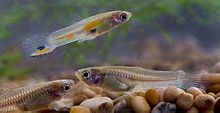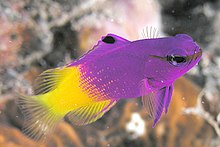User:Haplochromis/Work in progress
| Ovalentaria | |
|---|---|

| |
| Percula clownfish take care of their Eggs.
Eggs (the orange area under the stone) that stick with filaments on the surface, are a feature of Ovalentaria. | |
| Scientific classification | |
| Superclass: | |
| Class: | |
| Subclass: | |
| Infraclass: | |
| Superorder: | |
|
many, see text | |
The Ovalentaria (Lat. "Ovum" = egg, "lentae" = sticky or chewy) are a species-rich fish taxon (a systematic group) from the group of Percomorpha. The Ovalentaria include large groups of tropical freshwater fish like the Cichlids and Cyprinodontiformes, resident of coral reefs (Pomacentridae and Blennioidei) and taxa for which both marine fish as also brackish - and freshwater fish e are (Ambassidae, mullet and Silverside Related). Authors of the in 2012 established taxon are William Leo Smith of Field Museum of Natural History and Thomas J. Near of Peabody Museum of Natural History. The taxon includes more than 4800 species in 40 families, or 27% of the perch family and 16% of all fish species from the class of Actinopterygii. The close relationship of these outwardly different groups based on molecular studies and is only morphological features based on the eggs of animals.
The monophyly of parts of Ovalentaria was found in earlier phylogenetics work.[1] [2] but none of these studies included all taxa of this clade.
Most here, a group of ichthyologists of Muséum national d'histoire naturelle in Paris, who found a kinship group similar in composition to the Ovalentaria and proposed to form a new order, it "name Stiassnyiformes gave [3]
[4], in honor of curator Natural in the Department of Ichthyology at the American Museum of History Melanie Stiassny, who suspected as early as 1993 that are related to the mullets with groupers and Guppys [5]. They waived, however, a formal first description, and did not account for the principle of biological ranks, the one order not (eg the killifishes and live bearers (Cyprinodontiformes)) may belong to a different order.
Definition[edit]
The Ovalentaria are a node-based taxon including the most recent common ancestor of Ambassis urotaenia, Mugil cephalus, Embiotoca lateralis, Pseudochromis fridmani, Gobiesox maeandricus, Gillellus semicinctus, Polycentrus schomburgkii, Pholidichthys leucotaenia, Cichla temensis, Labidesthes sicculus, Gambusia affinis und Oryzias latipes and all descendants of that ancestor.
Merkmale[edit]
The defining feature of Ovalentaria are falling to the ground eggs, which adhere with adhesive filaments. In five taxa of Ovalentaria, at the surf perch s, the Zenarchopteridae, the Hochlandkärpflinge s, the viviparous tooth carp and some [[scaly blenny | scaly blennies] ], it came to the development of viviparity (Latin for "viviparus" = viviparous). The viviparity must be secondary in these cases and have developed independently. In others, secondary pelagic developed e eggs (Flying Fish and some garfish), or the pressure-sensitive adhesive filaments were lost again (at the mullet). Within Ovalentaria intensive parental care is found in many taxa (eg the cichlids and Pholidichthys [6] [7]).
In addition, many species share Ovalentaria in some of the following features that are not in the Diagnosis of the entire clade but can be used for important lines within the Ovalentaria.
- Verlust der Interarcual-Knorpels, eines Knorpels zwischen Epibranchiale I und Pharyngobranchiale II (Knochen des Kiemenbogenskeletts).
- Verlust von Neuralfortsätzen (Supraneuralia).
- a reduced number of Pharyngobranchialia.
- a reduced number of Branchiostegalstrahlen.
- the fusion of some parts of the tail fins Kletts.
Systematik[edit]




The Ovalentaria are in a sister group to a clade of Carangomorpha (crevalle Related and flatfish) and Anabantiformes (Labyrinth Fish, snakeheads and Synbranchiformes). All three taxa together are the sister group of the remaining "perch n", scorpion-like s and stickleback-like n
Das folgende Kladogramm gibt verwandtschaftlichen Beziehungen aller zu den Ovalentaria gehörenden Taxa wieder:
| Ovalentaria | |
Literatur[edit]
- Peter C. Wainwright, W. Leo Smith, Samantha A. Price, Kevin L. Tang, John S. Sparks, Lara A. Ferry, Kristen L. Kuhn, Ron I. Eytan & Thomas J. Near: The Evolution of Pharyngognathy: A Phylogenetic and Functional Appraisal of the Pharyngeal Jaw Key Innovation in Labroid fishes and Beyond. Syst Biol (2012) doi:10.1093/sysbio/sys060
References[edit]
- ^ William Leo Smith and Ward C. Wheeler: Polyphyly of the mail-cheeked fishes(Teleostei:Scorpaeniformes):evidence from mitochondrial and nuclear sequence data, Molecular Phylogenetics and Evolution Volume 32, Issue 2, August 2004, pages 627-646 Abstract online]
- ^ Setiamarga DH, Miya M, Yamanoue Y, Mabuchi K, Satoh TP, JG Inoue, M. Nishida: Inter Relationships of Atherinomorpha (medaka, flying fishes, . killifishes, silversides, and their relatives): The first evidence based on whole sequences mitogenome Molecular Phylogenetics and Evolution, Volume 49, Issue 2, November 2008, page 598-605 doi:10.1016/j.ympev.2008.08. 008
- ^ Blaise Li, Agnès Dettaï, Corinne Cruaud, Arnaud Couloux, Martine Desoutter Meniger, Guillaume Lecointre: RNF213, a new nuclear marker for acanthomorph phylogeny Molecular Phylogenetics. and Evolution, Volume 50, Issue 2, February 2009, pages 345-363 doi:10.1016/j.ympev.2008.11.013
- ^ American Museum of Natural History [http: / / www.amnh.org / science / papers / species_names.php AMNH scientists honored with an array of scientific names]
- ^ Melanie LJ Stiassny: What are Grey Mullets Bulletin of Marine Science, Volume 52, Number 1, January 1993, pp. 197-219 (23) Abstract
- ^ Ellen Thaler: Aalgrundeln and reproduction in the aquarium In. :. coral No. 39, 2006
- ^ W. Fresh, L. Gesset: Mysterious In Aalgrundeln. DATZ '. 'Vol 59, No. 1
